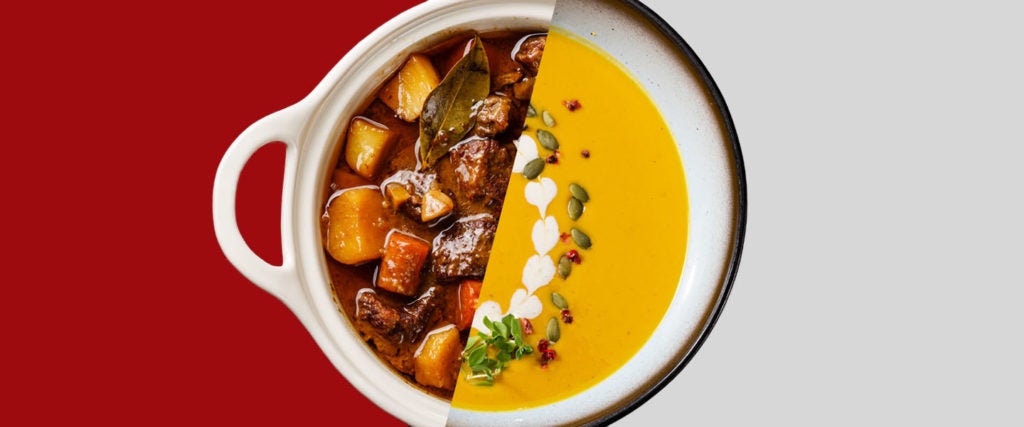Chances are, you’ve never confused a can of Campbell’s vegetable beef soup for a stew. It’s equally unlikely that you’ve had a bowl of large, tender chunks of beef and veggies in a liquid so thick it’s practically gravy and called it soup. Since the difference between the two dishes is the amount of liquid they contain, then logically it stands to reason that somewhere there is a line between them — a perfect ratio of liquid and solids where adding a single drop of broth into the mix turns a stew into soup, and taking a drop from a bowl of soup transforms it into a stew.
Right?
Wrong. The line between soup and stew is like the line between art and pornography — sometimes it’s extremely difficult to differentiate the two. Sure, there are some clear signs that can indicate which is which: “Soups typically have more liquid than stews because you want to [be able to] suspend the flavorful ingredients,” says culinary scientist Jessica Gavin. “For stews, you want just enough liquid to completely submerge the ingredients, so they properly cook.” Over time, this liquid gets reduced and becomes gravy-like, so it sticks to the meat and vegetables, which is why some cooks often add a thickening agent to it.
To put it more simply: If the ingredients are able to “swim” in the liquid, it’s a soup. If the ingredients are static and the liquid pools around them, it’s a stew. (There are a few other obvious rules: “Stews always contain identifiable pieces of meat and/or vegetables,” says Gavin. “You would never serve a stew cold and it is never completely smooth. And you don’t often see pasta in stews.”)
But there’s no agreed-upon ratio of food-to-liquid that defines either dish — no point where someone could add a single droplet of broth to a stew and a sane person would suddenly declare it a soup. “When both have chunks of protein or vegetables, it’s easy to get confused,” says Gavin. Even Wikipedia admits that at a certain point, it gets difficult to tell the two apart: “Stews are similar to soups, and in some cases there may not be a clear distinction between the two.”
It’s not a line that separates soups and stews, then, but a spectrum. On one end is a universally acknowledged soup, like the stuff that comes out of a Campbell’s can, for instance, and on the other is classic, traditional stew. In-between is a wide variety of soups that get increasingly thick and stews that get increasingly thin, which begin to overlap. At that point, they can only truly be identified via intent and perception.
Imagine a chef who decides to make an extra-hearty beef vegetable soup. Across town, a different chef starts making beef stew, but he’s a bit cold and decides to add a bit more broth than traditional stew recipes call for, just to help him warm up. These dishes are for all intents and purposes the same, but to Chef #1 it’s the thick soup he intended to make, while Chef #2 is happy with his broth-heavy stew. Meanwhile, Chef #3 is making traditional beef vegetable soup, but gets distracted and lets too much of the liquid boil away. At the same time, a criminal breaks into Chef #4’s house as he’s making stew; the thief tells the chef to freeze just as he’s adding the broth, forcing him to pour the entire carton in. The thief leaves, enigmatically taking only the remote control to the TV. Now Chef #3 is furious at his practically dried out soup, while Chef #4 bemoans his water-logged stew (and the loss of his remote control). But if the two traded dishes, they would have the soup and stew they had both desired, even though that wasn’t the intended dish.
I can offer definitive proof that no clear delineation exists between soup and stew thanks to mega-celebrity chef Rachael Ray and her “stoups,” a dish that, yes, is meant to perfectly straddle both worlds. You would think this would be the line, the perfect amalgamation of the soups and stews, but watch her make her “spaghetti and meatball stoup” from her old 30-Minute Meals show:
Ray calls the end result stoup, but if you look at it, you could easily see it as soup with way too much shit in it. Yet others might see it as an overly watery stew.
The cooking method used is one way you can differentiate between soups and stews. Soups can be made quickly and are frequently boiled to cook the ingredients (e.g., noodles) or reheat them (e.g., a bag of frozen, assorted veggies). As mentioned above, stews are usually a long-term process where large chunks of uncooked beef and raw vegetables are just barely covered in liquid and simmered over low heat for several hours to tenderize the ingredients and condense the flavors as the liquid cooks down. This is a process called — wait for it — stewing, which is another great clue you’re dealing with a stew.
But, unhelpfully, not all stews are stewed! Here’s Alton Brown’s Beef Stew recipe from a classic Good Eats episode, in which the only liquid he uses is a half-cup of apple cider vinegar and the drippings from the meat — it’s practically a pile of meat and potatoes lightly covered in sauce. (Looks quite good, though.)
If your ideas about soups and stews have been shaken to their very core, I apologize. We didn’t even talk about soups like bisques and chowders, which aren’t stews despite being suspiciously thick, or chili, which is considered stew by some but can also veer perilously close to being a straight-up meat sauce. (And for sanity’s sake, I’m not even going to bring up chili soup.)
Sometimes, the difference between soup and stew may be obvious, but sometimes it can only be determined by the eye of the beholder… and the palate of the devourer. Besides, as long as it tastes good, do names really matter?

